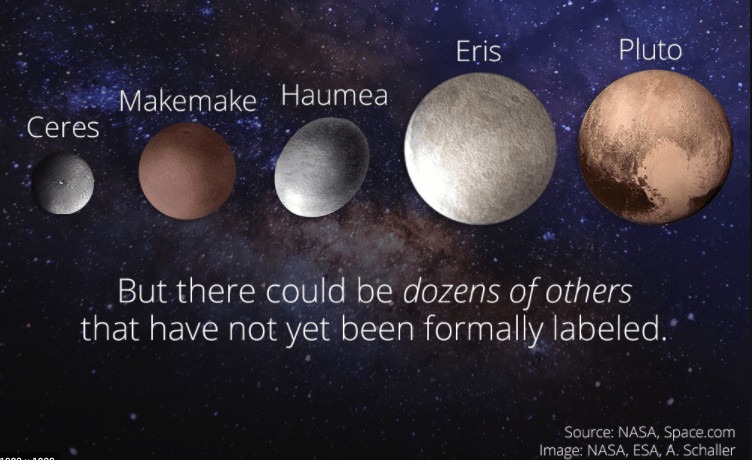Beyond Neptune, there are two structures — the Kuiper Belt and the Oort Cloud. They are made of a lot of icy debris, asteroids and comets.
Dwarf Planets
Dwarf Planets are minor planets that are circular but they cannot clear their orbital neighbourhood. They are mostly in the Kuiper Belt, but one, Ceres is in the Asteroid Belt. Now, let’s introduce each of them.
Ceres is the closest dwarf planet to Sun and it is located in the Asteroid Belt. It was recognised to be a planet before the Asteroid Belt was discovered. It is moonless and ringless, and it is 2.8 AU from Sun and it is 952 kilometres across. Ceres is also the largest object in the Asteroid Belt.
Pluto was the ninth planet, but it was downgraded by the IAU because of the Kuiper Belt’s discovery. It is 39.5 AU from Sun and it is 2,302 kilometres across and seven moons are larger than it. Pluto has five moons, and Charon is the largest one. Its diameter is halfway across Pluto. Pluto and Charon orbit around a barycenter apparently. Therefore, they tidally locked each other. It takes 248 years for Pluto to orbit Sun.
Haumea is a ringed dwarf planet, making it the first Kuiper Belt object known to be ringed. It is oval because of its rapid rotation. It has 2 known moons, which the outer Hi’iaka is larger, and the inner Namaka is smaller and it takes 285 years to orbit Sun.
Makemake is a reddish-brown dwarf planet and it has a moon nicknamed MK2. It takes 305 years to orbit Sun. It is 1,430 kilometres across and it is 46 AU from Sun.
Eris is the largest dwarf planet in the Solar System and weighs 27% more than Pluto and it is 2,326 kilometres across. It is also the farthest dwarf planet from Sun at a distance of 68 AU, taking 557 years to orbit it once. It has a moon in orbit, Dysnomia.
There are a lot of dwarf planet candidates, awaiting approval from IAU. This includes Gonggong, Sedna, Quaoar, Orcus, etc.
Kuiper Belt
Other than dwarf planets, Kuiper Belt also has a lot of icy debris and comets, which are iceballs evaporating near Sun. One famous example is Arrokoth, which New Horizons made a flyby of it in 2019. There are also a lot of TNOs, which are trans-Neptunian objects. Thousands of examples are known, but there are a lot more to be discovered.
Kuiper Belt has two components — the inner, main belt, and the outer scattered disk. The main one stretches to 50 AU from Sun, and the scattered disk, even further, 1,000 AU. They share some similarities to the Asteroid Belt, including the TNOs cannot form planets.
But there might be a planet in the Kuiper Belt, even possibly a small black hole, centimetres across. It is the unconfirmed Planet 9. It rules the Kuiper Belt, making the TNOs’ orbits being not free across Kuiper Belt. Over years of observations, it is not discovered yet. Here are some reasons:
1. It is a primordial black hole
2. It’s too far away
3. Its bond albedo is too low
4. It’s obscured by TNOs
The Oort Cloud
The Oort Cloud is so far away, that not even a single object of it has been spotted… So it is considered theoretical.
The Oort Cloud is home to long-period comets so we see, and will see a lot of comets flying through the inner Solar System and swing out in an incredible velocity.
Its inner edge is about 2,000 to 5,000 AU from Sun, and its outer edge is even more incredible — comparable to the distance between the neighbouring star, about a light year from Sun! That’s why it could get a lot of acceleration from Sun and even reach escape velocity. That means the comet can escape the Solar System, leaving interstellar objects like Oumuamua.


